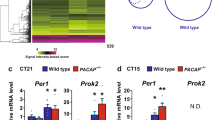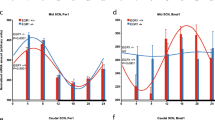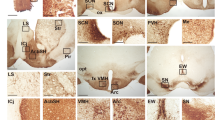Abstract
In mammals circadian rhythms are generated by a light-entrainable oscillator located in the hypothalamic suprachiasmatic nucleus (SCN). Light signals reach the SCN via a monosynaptic neuronal pathway, the retinohypothalamic tract, originating in a subset of retinal ganglion cells. The nerve terminals of these cells contain the classical neurotransmitter glutamate and the neuropeptide pituitary adenylate cyclase-activating polypeptide (PACAP), and there is evidence that these two transmitters interact to mediate photoentrainment of the oscillator in the SCN. To elucidate light-provoked PACAP receptor signaling we used proteomic analysis. Wild-type mice and mice lacking the PAC1 receptor (PAC −/−1 ) were light stimulated at early night, and the SCN was examined for proteins that were differentially expressed using two-dimensional gel electrophoresis and identification by tandem mass spectrometry. The most striking finding, which was subsequently confirmed by Western blotting, was a significant reduction of calmodulin (CaM) in wild-type mice as compared with PAC −/−1 mice. Analysis at the mRNA level by quantitative in situ hybridization histochemistry was inconclusive, indicating that a translational mechanism might be involved. The findings indicate that PAC1 receptor signaling in the SCN in response to light stimulation induces a down-regulation of CaM expression and that CaM is involved in the photic-entrainment mechanism.
Similar content being viewed by others
References
Bergström A. L., Hannibal J., Hindersson P., and Fahrenkrug J. (2003) Light-induced phase shift in the Syrian hamster (Mesocricetus auratus) is attenuated by the PACAP receptor antagonist PACAP6-38 or PACAP immunoneutralization. Eur. J. Neurosci. 18, 2552–2562.
Caceres A., Bender P., Snavely L., Rebhun L. I., and Steward O. (1983) Distribution and subcellular localization of calmodulin in adult and developing brain tissue. Neuroscience 10, 449–461.
Chen D., Buchanan G. F., Ding J. M., Hannibal J., and Gillette M. U. (1999) PACAP: a pivotal modulator of glutamatergic regulation of the suprachiasmatic circadian clock. Proc. Natl. Acad. Sci. U. S. A. 96, 13,409–13,414.
Ehlers M. D., Zhang S., Bernhardt J. P., and Huganir R. L. (1996) Inactivation of NMDA receptors by direct interaction of calmodulin with the NR1 subunit. Cell 84, 745–755.
Eldik L. and Watterson D. M. (1998) Calmodulin and Signal Transduction. Academic Press, New York.
Fahrenkrug J., Nielsen H. S., and Hannibal J. (2004) Expression of melanopsin during development of the rat retina. NeuroReport 15, 781–784.
Gillette M. U. and Mitchell J. W. (2002) Signaling in the suprachiasmatic nucleus: selectively responsive and integrative. Cell Tissue Res. 309, 99–107.
Goldenring J. R., McGuire J. S., and DeLorenzo R. J. (1984) Identification of the major postsynaptic density protein as homologous with the major calmodulin binding subunit of a calmodulin-dependent protein kinase. J. Neurochem. 42, 1077–1084.
Golombek D. A., Ferreyra G. A., Agostino P. V., Murad A. D., Rubio M. F., Pizzio G. A., et al. (2003) From light to genes: moving the hands of the circadian clock. Front. Biosci. 8, 285–293.
Gooley J. J., Lu J., Chou T. C., Scammell T. E., and Saper C. B. (2001) Melanopsin in cells of origin of the retinohypothalamic tract. Nat. Neurosci 12, 1165.
Hannibal J., Ding J. M., Chen D., Fahrenkrug J., Larsen P. J., Gillette M. U., and Mikkelsen J. D. (1997) Pituitary adenylate cyclase activating peptide (PACAP) in the retinohypothalamic tract. A daytime regulator of the biological clock. J. Neurosci. 17, 2637–2644.
Hannibal J., Hindersson P., Knudsen S. M., Georg B., and Fahrenkrug J. (2002) The photopigment melanopsin is exclusively present in PACAP containing retinal ganglion cells of the retinohypothalamic tract. J. Neurosci. 22:RC191, 1–7.
Hannibal J., Jamen F., Nielsen H. S., Journot L., Brabet P., and Fahrenkrug J. (2001) Dissociation between light induced phase shift of the circadian rhythm and clock gene expression in mice lacking the PACAP type 1 receptor (PAC1). J. Neurosci. 21, 4883–4890.
Hannibal J., Moller M., Ottersen O. P., and Fahrenkrug J. (2000) PACAP and glutamate are co-stored in the retinohypothalamic tract. J. Comp. Neurol. 418, 147–155.
Harmar A. J., Arimura A., Gozes I., Journot L., Laburthe M., et al. (1998) International union of pharmacology. XVIII. Nomenclature of receptors for vasoactive intestinal peptide and pituitary adenylate cyclase-activating polypeptide. Pharmacol. Rev. 50, 265–270.
Harrington M. E., Hoque S., Hall A., Golombek D., and Biello S. (1999) Pituitary adenylate cyclase activating peptide phase shifts circadian rhythms in a manner similar to light. J. Neurosci. 19, 6637–6642.
Hattar S., Liao H. W., Takao M., Berson D. M., and Yau K. W. (2002) Melanopsin-containing retinal ganglion cells: architecture, projections, and intrinsic phosensitivity. Science 295, 1065–1070.
Honoré B., Østergaard M., and Vorum H. (2004a) Functional genomics studied by proteomics. Bioessays 26, 901–915.
Honoré B., Vorum H., Pedersen A. E., Buus S., and Claësson M. H. (2004b) Changes in protein expression in p53 deleted spontaneous thymic lymphomas. Exp. Cell Res. 295, 91–101.
Jamen F., Persson K., Bertrand G., Rodriguez-Henche N., Puech R., et al. (2000) PAC1 receptor-deficient mice display impaired insulinotropic response to glucose and reduced glucose tolerance. J. Clin. Invest. 105, 1307–1315.
Klein D. C., Moore R. Y., and Reppert S. M. (1991) Suprachiasmatic nucleus. The mind’s clock. Oxford University Press, New York.
Kortvely E. and Gulya K. (2004) Calmodulin, and various ways to regulate its activity. Life Sci. 74, 1065–1070.
Mikkelsen J. D., Hannibal J., Larsen P. J., and Fahrenkrug J. (1994) Pituitary adenylate cyclase activating peptide (PACAP) mRNA in the rat neocortex. Neurosci. Lett. 171, 121–124.
Minami Y., Furuno K., Akiyama M., Moriya T., and Shibata S. (2002) Pituitary adenylate cyclase-activating polypeptide produces a phase shift associated with induction of mPer expression in the mouse suprachiasmatic nucleus. Neuroscience 113, 37–45.
Moore R. Y., Speh J. C., and Card J. P. (1995) The retinohypothalamic tract originates from a distinct subset of retinal ganglion cells. J. Comp. Neurol. 352, 351–366.
Palfi A., Vizi S., and Gulya K. (1999) Differential distribution and intracellular targeting of mRNAs corresponding to the three calmodulin genes in rat brain: a quantitative in situ hybridization study. J. Histochem. Cytochem. 47, 583–600.
Piggins H. D., Marchant E. G., Goguen D., and Rusak B. (2001) Phase-shifting effects of pituitary adenylate cyclase activating polypeptide on hamster wheel-running rhythms. Neurosci. Lett. 305, 25–28.
Provencio I., Rollag M. D., and Castrucci A. M. (2002) Photoreceptive net in the mammalian retina. This mesh of cells may explain how some blind mice can still tell day from night. Nature 415, 493.
Reppert S. M. and Weaver D. R. (2002) Coordination of circadian timing in mammals. Nature 418, 935–941.
Roenneberg T. and Foster R. G. (1997) Twilight times: light and the circadian system. Photochem. Photobiol. 66, 549–561.
Saimi Y. and Kung C. (2002) Calmodulin as an ion channel subunit. Annu. Rev. Physiol. 64, 289–311.
Shevchenko A., Wilm M., Vorm O., and Mann M. (1996) Mass spectrometric sequencing of proteins from silver-stained polyacrylamide gels. Anal. Chem. 68, 850–858.
Shimizu Y., Akiyama K., Kodama M., Ishihara T., Hamamura T., and Kuroda S. (1997) Alterations of calmodulin and its mRNA in rat brain after acute and chronic administration of methamphetamine. Brain Res. 765, 247–258.
Solá C., Tusell J. M., and Serratosa J. (1996) Comparative study of the pattern of expression of calmodulin messenger RNAs in the mouse brain. Neuroscience 75, 245–256.
Tran Q. K., Black D., and Persechini A. (2003) Intracellular coupling via limiting calmodulin. J. Biol. Chem. 278, 24,247–24,250.
Author information
Authors and Affiliations
Corresponding author
Rights and permissions
About this article
Cite this article
Fahrenkrug, J., Hannibal, J., Honoré, B. et al. Altered calmodulin response to light in the suprachiasmatic nucleus of PAC1 receptor knockout mice revealed by proteomic analysis. J Mol Neurosci 25, 251–258 (2005). https://doi.org/10.1385/JMN:25:3:251
Received:
Accepted:
Issue Date:
DOI: https://doi.org/10.1385/JMN:25:3:251




